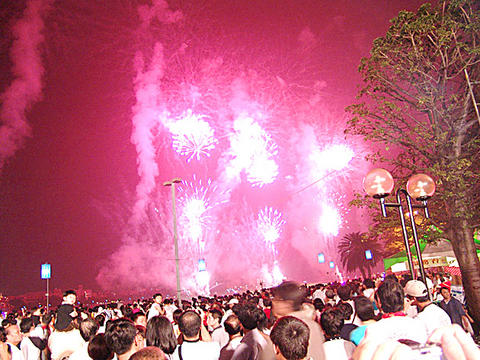The Kaohsiung Tsoying Wannian Folklore Festival (高雄左營萬年季), now in its seventh year, is second only to the Kaohsiung Lantern Festival (高雄燈會) in the calendar of cultural events in southern Taiwan. Held every October, it is an extension of traditional religious activities centered on the Tzichi Temple (慈濟宮) - originally dedicated to the Baosheng Emperor (保生大帝), it has since developed into a celebration of southern Taiwanese culture. With a mixture of religion, showmanship, fireworks and fun, the festival has been billed as Kaohsiung's response to Mardi Gras.
The festival is closely tied to southern Taiwan's history and takes its name, Wannian, from the old name of the Tsoying District, which under the administration of Koxinga (鄭成功) in the 1660s, was designated Wannian County. Religion also roots the festival firmly in the past, as the Tzichi Temple and the "welcoming of the fire lion," the centerpiece of the festival, date back to the early 18th century.
Given Tsoying's history as part of the first Chinese settlements in Taiwan, it is no surprise that temples abound. Ten major temples in the Tsoying area will all be holding their own activities as part of the festivities. The area around Kaohsiung's Lotus Lake (蓮池潭) will host traditional entertainments over the nine days of the festival, which starts tomorrow.

PHOTOS: COURTESY OF THE KAOHSIUNG CITY GOVERNMENT
The fire lion is regarded as the Baosheng Emperor's steed and messenger. Every year, a huge image of the fire lion made of bamboo and paper and containing slips of paper on which are written the hopes and prayers of devotees, is paraded through the streets and then set alight amid a shower of fireworks as the climax of the festivities.
A spokesperson for the Kaohsiung City Civil Affairs Bureau (高雄市民政局) said this year's festival, will be more accessible to people from around the island as the High Speed Railway is in service. Detailed information about the numerous events taking place can be found at cabu.kcg.gov.tw/ks2007/contents_04_1.html (Chinese only).

Many people noticed the flood of pro-China propaganda across a number of venues in recent weeks that looks like a coordinated assault on US Taiwan policy. It does look like an effort intended to influence the US before the meeting between US President Donald Trump and Chinese dictator Xi Jinping (習近平) over the weekend. Jennifer Kavanagh’s piece in the New York Times in September appears to be the opening strike of the current campaign. She followed up last week in the Lowy Interpreter, blaming the US for causing the PRC to escalate in the Philippines and Taiwan, saying that as

US President Donald Trump may have hoped for an impromptu talk with his old friend Kim Jong-un during a recent trip to Asia, but analysts say the increasingly emboldened North Korean despot had few good reasons to join the photo-op. Trump sent repeated overtures to Kim during his barnstorming tour of Asia, saying he was “100 percent” open to a meeting and even bucking decades of US policy by conceding that North Korea was “sort of a nuclear power.” But Pyongyang kept mum on the invitation, instead firing off missiles and sending its foreign minister to Russia and Belarus, with whom it

The Chinese Communist Party (CCP) has a dystopian, radical and dangerous conception of itself. Few are aware of this very fundamental difference between how they view power and how the rest of the world does. Even those of us who have lived in China sometimes fall back into the trap of viewing it through the lens of the power relationships common throughout the rest of the world, instead of understanding the CCP as it conceives of itself. Broadly speaking, the concepts of the people, race, culture, civilization, nation, government and religion are separate, though often overlapping and intertwined. A government

Nov. 3 to Nov. 9 In 1925, 18-year-old Huang Chin-chuan (黃金川) penned the following words: “When will the day of women’s equal rights arrive, so that my talents won’t drift away in the eastern stream?” These were the closing lines to her poem “Female Student” (女學生), which expressed her unwillingness to be confined to traditional female roles and her desire to study and explore the world. Born to a wealthy family on Nov. 5, 1907, Huang was able to study in Japan — a rare privilege for women in her time — and even made a name for herself in the